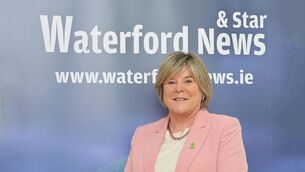New initiative offers intriguing insight into Waterford and Ireland's history in a unique way

At the launch of Waterford County Museum's audiobook series were Museum Secretary Christine King, President Thomas Phelan, Project Manager Willie Whelan, and Treasurer Paula Houlihan.
Waterford County Museum has created its own bit of history by utilising AI technology in what they believe is a first for an Irish museum.
The museum used the technology to 'Voice the Past' through the release of four audiobooks using AI software to convert text to speech.
These expertly researched works offer listeners insights into Ireland’s revolutionary years, the Great Famine, and the everyday life of rural communities.
Welcoming the conclusion of the initial phase of the project, Waterford County Museum President Thomas Phelan stated: "The museum has always aimed to be innovative in how we present history. We were early adopters of the World Wide Web [and] our image archive, walking trail app, community archaeology programme, and recent venture into book publishing have all been driven by a desire to bring local history to the widest possible audience."
"These audiobooks are yet another way of broadening access to the history of our locality," said Thomas.
Commenting on the release, Museum Curator, William Fraher added: “Although the museum is based in Dungarvan, we have always been acutely aware that our audience is global, thanks to the Irish diaspora."
"I’m particularly delighted to see 'Desperate Haven' among the publications now available in audiobook format," he said.
"First published in 1996, to mark the 150th anniversary of the Great Famine in West Waterford, it remains one of the major achievements of Dungarvan Museum Society which was the precursor to Waterford County Museum," he added.

Project manager for the museum, Willie Whelan also commented on the project and he highlighted the level of content in the books.
“The cost of audiobook production has meant that it has remained out of reach for even the largest cultural institutions," he said.
"What has been produced to date in Ireland has mainly been hour long audio guides," he added.
"Together, these four audiobooks contain more than 30 hours of content; a remarkable technical achievement for a volunteer-run museum."
Willie said the museum's use of narration software highlighted the potential of AI tools to make local history accessible to global audiences - particularly the diaspora.
"I’d hope it will serve to showcase the opportunities presented by Artificial Intelligence and serve as a model for other small museums with limited resources looking to punch above their weight," he said.
The books in the series include: 'Bloodshed in the Comeraghs: The Civil War Killing of IRA Guerrilla Thomas Keating', by David Prendergast and the audio length is six hours and 45 minutes.
At just 30 years of age, Thomas Keating was killed in the Comeragh Mountains during the closing stages of the Civil War. His story, often overshadowed by more well-known figures, is one of defiant resistance in the face of internal strife and dwindling support.

Another book, 'The Bad Times: Waterford Country Houses During the Revolutionary Period', by William Fraher is 7hrs 34mins in duration and draws on a wide range of archival sources, including personal diaries and compensation claims. The book offers a vivid portrait of the impact of revolution on the Anglo-Irish gentry, their servants, and the surrounding countryside. The audiobook also explores the long-term economic and social shifts that followed the Land Acts and the decline of the landlord class.
'Desperate Haven: The Poor Law, Famine & Aftermath in Dungarvan Union', by William Fraher, William Whelan, Bernadette Sheridan, and Seosaimh Ó Loingsigh is another one of the books and one referred to by William Fraher.
It's 8hrs 38mins in lengthe and is a definitive local study of the Great Famine in West Waterford and has long been out of print. Now available as an audiobook, the book traces the history of the Dungarvan Poor Law Union from its establishment in 1839 to 1920. Using workhouse minute books, Famine Relief Papers, and local newspapers, the authors document the stark realities of life in the workhouse, the devastation wrought by hunger and disease, and the mass emigration that reshaped the region.
The fourth book in the series, 'Ardmore: Memory and Story', by Siobhán Lincoln is 8hrs 8mins in length and is a tender and humorous account of life in Ardmore. The audiobook is a love letter to an Irish village and its people. Through memories of school, fishing, local customs, and community life, Siobhán Lincoln captures a fading world with warmth and affection. Introduced by Fergal Keane, who praises the author’s role in preserving local memory, the book is both a social history and a celebration of place.
The audiobooks are currently available on Amazon.com and Audible.com, or free with an Audible subscription. European availability is expected shortly, but in the meantime, setting up a free Amazon.com account allows access for €3.99 each.
Hardback, paperback and kindle editions of all eight Waterford County Museum publications in their Waterford History Series are available to buy online, at the museum, and through booksellers across Waterford. To purchase hard copies of the book online visit https://bit.ly/museumbooks or www.waterfordmuseum.ie






